Kukulkan facts for kids
Quick facts for kids Kukulkan |
|
|---|---|
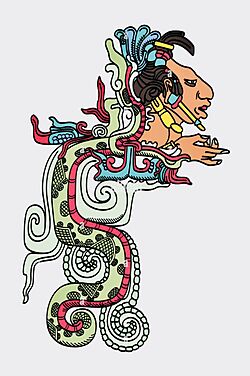
Reconstructed 2D-portrait of Kukulkan
|
|
| Major cult center | Chichen Itza |
| Symbol | Serpent |
| Equivalents | |
| Aztec equivalent | Quetzalcoatl |
| Inca equivalent | Viracocha |
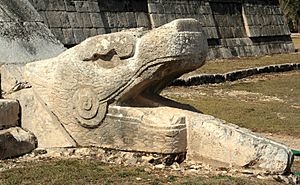
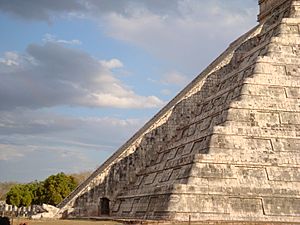
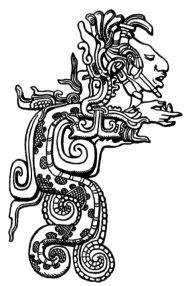
Kukulkan, also sometimes spelled K’uk’ulkan, is a very important Maya god. His name means "Plumed Serpent" or "Amazing Serpent." He is a powerful serpent deity who was honored by the ancient Maya people.
Kukulkan is similar to other famous gods from ancient Mesoamerica. He is closely related to Qʼuqʼumatz, a god of the Kʼicheʼ people, and to Quetzalcoatl, a well-known god in Aztec mythology. You can find impressive temples built for Kukulkan at ancient sites like Chichen Itza, Uxmal, and Mayapan in the Yucatán Peninsula of Mexico.
The idea of a feathered serpent god was important in many ancient cultures across Mesoamerica. Even though Kukulkan became very popular with influences from central Mexico, his story began with the Maya people during their Classic Period. We don't know all the details of his ancient myths, but he was clearly a significant figure.
Contents
What Does the Name Kukulkan Mean?
In the Yucatec Maya language, the name is written as Kʼukʼulkan. In the Tzotzil language, it is Kʼukʼul-chon. The Yucatec name comes from the word kuk, meaning "feather," and kan, meaning "snake." So, "Kukulkan" literally means "feathered snake."
Long ago, during the Classic Period of the Maya, Kukulkan was also known as Waxaklahun Ubah Kan. This name meant "War Serpent." He was also seen as a later version of the Vision Serpent, which was a spiritual guide in Classic Maya art.
A Long History
The worship of Kukulkan, and his Aztec counterpart Quetzalcoatl, was one of the first ancient religions in Mesoamerica to bring different groups of people together. This shared belief helped people from various backgrounds communicate and trade peacefully.
Even though the main center for this worship was the ancient city of Chichen Itza in modern Yucatán, Mexico, it spread far and wide. It reached places like the Guatemalan Highlands and northern Belize.
Sometimes, stories about the god Kukulkan can be a bit confusing. This is because there was also a real historical person who had the same name as the god. This person might have been a ruler or a priest in Chichen Itza around the 10th century. Over time, the stories of the god and the person became mixed up.
However, ancient texts from Chichen Itza, written in the 9th century, always showed Kukulkan as a god. He was often depicted as a Vision Serpent wrapped around important nobles. He was also shown in important ceremonies.
Kukulkan and the Itza People
Kukulkan was especially important to the Itza people who lived in the northern Yucatán Peninsula. His worship was a central part of their religion and helped shape their society.
While the worship of Kukulkan started with older Maya traditions, the Itza people's way of honoring him was greatly influenced by the Quetzalcoatl religion from central Mexico. This influence likely came from Putún Maya merchants who traveled from the Gulf Coast of Mexico. These traders probably helped spread the worship of the feathered serpent across Mesoamerica.
Kukulkan was at the head of many gods, some Maya and some from other cultures. This mix of gods helped the Itza people with their trade and political goals. It also made it easier for Itza merchants to travel and trade in central Mexico and other non-Maya areas, boosting their economy.
At Chichen Itza, Kukulkan changed from being a Vision Serpent, who acted as a messenger between kings and gods, to representing the sacredness of the land itself.
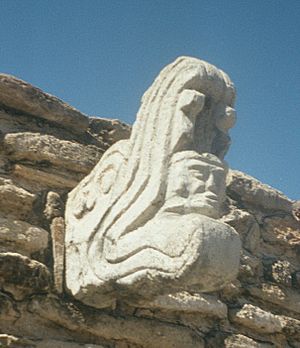
The Amazing Chichen Itza Pyramid
The famous pyramid at El Castillo, Chichen Itza was a special temple dedicated to Kukulkan. Twice a year, during the spring and fall equinoxes, something amazing happens. The sun's angle creates a shadow that looks like a giant serpent slithering down the pyramid's northern stairway. This shadow connects with the stone serpent heads carved at the base, making it seem as if Kukulkan himself is descending the pyramid.
After Chichen Itza declined, the nearby city of Mayapan became a new center for Kukulkan worship. Temples there were decorated with columns shaped like feathered serpents. When the Spanish arrived in the Americas, the high priest of Kukulkan was a very powerful leader in Mayapan.
The religion of Kukulkan also spread to the Guatemalan Highlands and northern Belize. In these areas, you can find ancient sculptures of feathered serpents with open mouths, from which the heads of human warriors appear.
Kukulkan in Today's Stories
Even today, the modern Yucatec Maya people still tell stories about Kukulkan. In one tale, Kukulkan was born as a snake. As he grew, it became clear he was the great plumed serpent. His sister cared for him in a cave. He grew so large that his sister could no longer feed him. So, he flew out of his cave and into the sea, causing an earthquake. To let his sister know he is still alive, Kukulkan causes small earth tremors every year in July.
Another story from Yucatán folklore says that Kukulkan was a winged serpent who flew to the sun. He tried to speak to the sun, but the proud sun burned his tongue. This same story also tells how Kukulkan always travels ahead of Chaac, the Yucatec Maya rain god. Kukulkan helps predict the rains by moving the winds with his tail and sweeping the earth clean.
Among the Lacandon Maya in Chiapas, Kukulkan is sometimes described as a powerful, monstrous snake. In one story, she destroys much of the world. During a long journey between life and death, she meets a boy who shares food with her. She follows him back to the human world and builds her own country there.
See also
 In Spanish: Kukulcán para niños
In Spanish: Kukulcán para niños
- Chichen Itza, an ancient Maya city
- Kukulcania, a type of crevice weaver spider named after this god.

